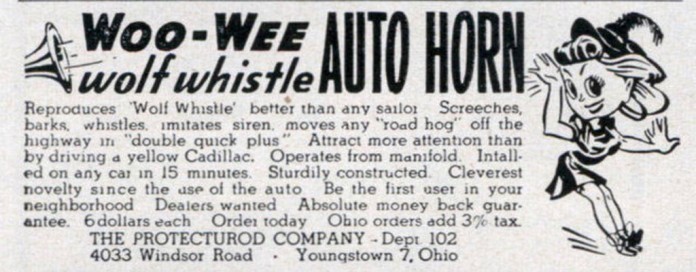
Ever wonder why every automobile comes equipped with a horn? Well, I didn’t either, but while reading an 1896 issue of the magazine, The Horseless Age, I found out the reason.
At the dawn of the automotive age, there were apparently people who thought that the new-fangled horseless carriages should be noiseless, but the magazine disagreed.
They wrote, “Noise is inseparable from locomotion, and the higher the speed, the greater the noise.”
They went on to cite the warning signals of the existing modes of transportation — the clang of the trolley gong, the jingle of the bell on a bicycle, and the bell and whistle of the locomotive. They admitted that ambulances and fire apparatuses also used warning gongs, but pointed out that the distinctive, high-pitched whine of the electric motors that drove trolley and street cars differentiated them from emergency vehicles.
Warning device
The author wrote, “The necessity of a similar warning (device) disappears in the horse vehicle for the reason that the horse announces his coming with his hoofs, and the animal himself has some skill in avoiding danger.”
While the horse-drawn rig was quieter when at rest than a motor vehicle (unless its engine was shut down), “on the road the animal sends his warning message farther than the motor,” the article went on.
The bicycle, which was in its heyday in the 1890s, was probably the most noiseless of all vehicles, except perhaps the electric car, which hadn’t really yet caught on in 1896, when this article was written, and bicyclists, or “wheelmen,” as they were then known, were required by law to have a bell and to use it frequently.
Personal experience
I can attest to how quiet a bike is as I often walk on the bike trail that runs between Washingtonville and Lisbon, and without a signal of some kind the bike is right beside me before I hear it. In fairness, most riders on the trail do warn a walker when overtaking. Interestingly, when the bicycle craze was at its height there were so many “wheels” buzzing around the streets of Washington, D.C., all of them frantically jangling their bells, that “their tone was so little appreciated by the horses of the Capital that the city authorities forbade them entirely.”
So, the author opined, if the motor vehicle required an audible warning signal, what should it be? The tinkle of a bell was associated by most folks with a bicycle, the clanging gong and motor whine with a trolley and a gong with the sound of galloping hooves meant an emergency vehicle was fast approaching.
Apparently, a few of the steam wagons then around had whistles for warning devices, but the author pointed out that a whistle was usually associated with an oncoming train and should probably be reserved for that purpose.
So, what was left? The Horseless Age decided that the only answer was the “Paris horn,” although what exactly that was is not described. It does point out that “The sound emitted by the Paris horn is not a musical one, but a danger signal should startle rather than please. The quality of the sound might easily be improved, and so, probably, might the quality of the rubber bulbs, which are said to crack under frequent pressure.”
I take it from this to mean the coiled brass bulb horn, with which many early cars were equipped. The editor invited suggestions from readers of The Horseless Age, and several of them advocated using escaping exhaust gasses to operate whistles, vibrating bells or horns; one even held out for a simple, lever-operated exhaust cutout as he thought the sound of the unmuffled exhaust would be warning enough.
Vibrating bell
Another wrote, “I am strongly in favor of the vibrating bell. Its sound is readily located and has not the paralyzing effect of a gong; it also has not the long-distance penetrating effect of the horn or whistle. Deliver me from living in a city with the driver of every vehicle tooting a horn.”
However, that’s exactly what happened. The bulb horn became pretty much standard on cars and trucks for a decade or more, and drivers weren’t shy about using it. In November 1911, the Good Roads Congress resolved “That the unnecessary use of warning signals should be avoided, and that an adequate warning signal should produce an abrupt sound, sufficiently loud to be heard under all conditions of traffic, and that its use–except as a warning of danger — should be prohibited by law.”
As car batteries became common, the electric klaxon horn was adopted — one klaxon manufacturer said in a 1911 ad, “The bulb-horn must go,” — and everyone recognizes Henry Ford’s “A-oogah” horn (I had one rigged up on my 1940 Dodge when I was a teenager).
Different sounds
By the 1920s, car horns mostly had a “Beep” sound (except for Ford), while in the ’30s, horns were becoming more musical, often having dual trumpets with different tones to enhance the sound. Probably sometime prior to World War II, after-market musical horns became available, some that played a preset tune, while others actually had a small steering column-mounted keyboard on which different tunes could be played.
And, although exhaust whistles had been around since the ‘teens, wolf whistles were all the rage when I was a kid and a couple of my buddies had these gadgets on their cars. The wolf whistle (which is still available) screwed into the car manifold and when a pull cable to the dashboard was manipulated, a loud, ear-piercing whistle resulted. With a little practice, the sound could be made to imitate the time-honored salute given to a pretty girl (yeah, we were sexist back in those unenlightened days).
So next time you honk your horn at some blooming idiot who cuts you off in traffic, you’ll know why you’re not clanging a bell or blowing a whistle at him. The popular one-finger salute is another story.












